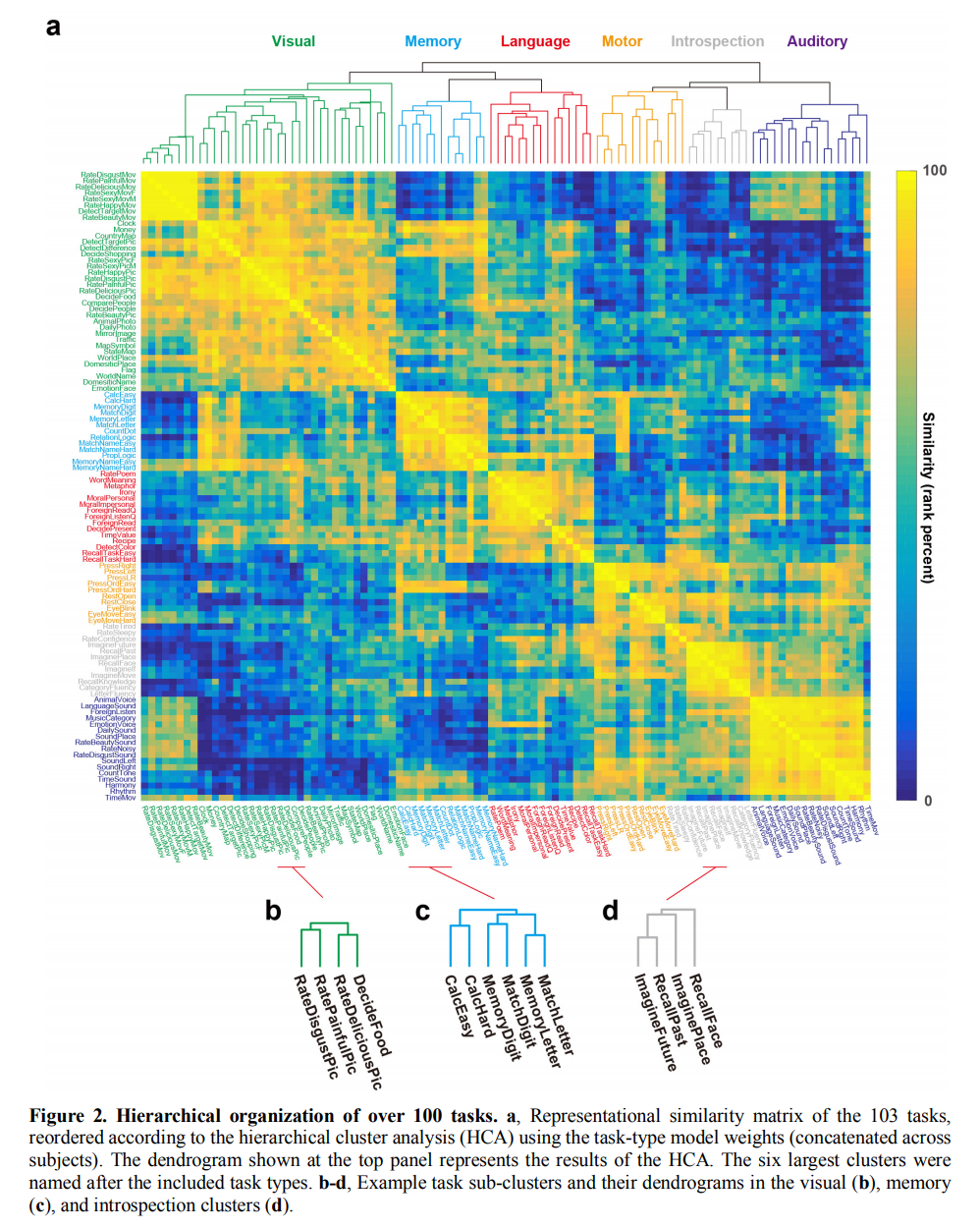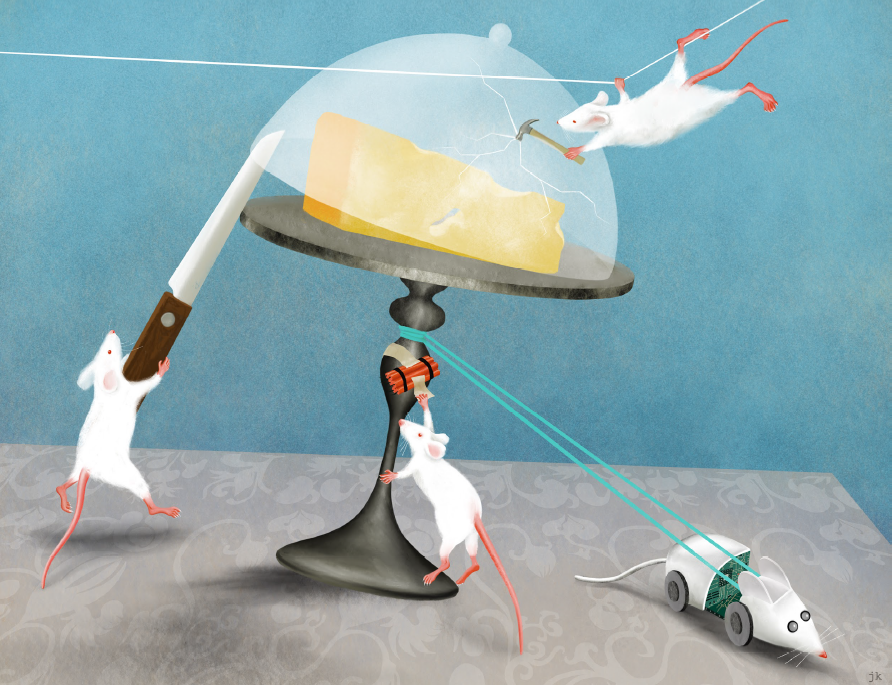[I8R7]
Nakai and Nishimoto (pp2019) had each of six subjects perform 103 naturalistic cognitive tasks during functional magnetic resonance imaging (fMRI) of their brain activity. This type of data could eventually enable us to more compellingly characterize the localization of cognitive task components across the human brain.
What is unique about this paper is the fact that it explores the space of cognitive tasks more systematically and comprehensively than any previous fMRI study I am aware of. It’s important to have data from many tasks in the same subjects to more quantitatively model how cognitive components, implemented in different parts of the brain, contribute in combination to different tasks.
The authors describe the space of tasks using a binary task-type model (with indicators for task components) and a continuous cognitive-factor model (with prior information from the literature incorporated via Neurosynth). They perform encoding and decoding analyses and investigate the clustering of task-related brain activity patterns. The model-based analyses are interesting, but also a bit hard to interpret, because they reveal the data only indirectly: through the lens of the models – and the models are very complex. It would be good to see some more basic “data-driven” analyses, as the title suggests.
However, the more important point is that this is a visionary contribution from an experimental point of view. The study pushes the envelope of cognitive fMRI. The biggest novel contributions are:
- the task set (with its descriptive models)
- the data (in six subjects)
Should the authors choose to continue to work on this, my main suggestions are (1) to add some more interpretable data-driven analyses, and (2) to strengthen the open science component of the study (by sharing the data, task and analysis code, and models), so that it can form a seed for much future work that builds on these tasks, expanding the models, the data, and the analyses beyond what can be achieved by a single lab.
This rich set of tasks and human fMRI responses deserves to be analyzed with a wider array of models and methods in future studies. For example, it would be great in the future to test a wide variety of task-descriptive models. Eventually it might also be possible to build neural network models that can perform the entire set of tasks. Explaining the measured brain-activity with such brain-computational models would get us closer to understanding the underlying information processing. In addition, the experiment deserves to be expanded to more subjects (perhaps 100). This could produce a canonical basis for revisiting human cognitive fMRI at a greater level of rigor. These directions may not be realistic for a single study or a single lab. However, this paper could be seminal to the pursuit of these directions as an open science endeavor across labs.
Improvements to consider if the authors chose to revise the paper
(1) Reconsider the phrase “data-driven models” (title)
The phrase “data-driven models” suggests that the analysis is both data-driven and model-based. This suggests the conceptualization of data-driven and model-based as two independent dimensions.
In this conceptualization, an analysis could be low on both dimensions, restricting the data to a small set (e.g. a single brain region) and failing to bring theory into the analysis through a model of some complexity (e.g. instead computing overall activation in the brain region for each experimental condition). Being high on both dimensions, then, appears desirable. It would mean that the assumptions (though perhaps strong) are explicit in the model (and ideally justified), and that the data still richly inform the results.
Arguably this is the case here. The models the authors used have many parameters and so the data richly inform the results. However, the models also strongly constrain the results (and indeed changing the model might substantially alter the results – more on that below).
But an alternative conceptualization, which seems to me more consistent with popular usage of these terms, is that there is a tradeoff between data-driven and model-based. In this conceptualization the overall richness of the results (how many independent quantities are reported) is considered a separate dimension. Any analysis combines data and assumptions (with the latter ideally made explicit in a model). If the model assumptions are weak (compared to the typical study in the same field), an analysis is referred to as data-driven. If the model assumptions are strong, then an analysis is referred to as model-driven. In this conceptualization, “data-driven model” is an oxymoron.
(2) Perform a data-driven (and model-independent) analysis of how tasks are related in terms of the brain regions they involve
“A sparse task-type encoding model revealed a hierarchical organization of cognitive tasks, their representation in cognitive space, and their mapping onto the cortex.” (abstract)
I am struggling to understand (1) what exact claims are made here, (2) how they are justified by the results, and (3) how they would constrain brain theory if true. The phrases “organization of cognitive tasks” and “representation in cognitive space” are vague.
The term hierarchical (together with the fact that a hierarchical cluster analysis was performed) suggests that (a) the activity patterns fall in clusters rather than spreading over a continuum and (b) the main clusters contain nested subclusters.
However, the analysis does not assess the degree to which the task-related brain activity patterns cluster. Instead a complex task-type model (whose details and influence on the results the reader cannot assess) is interposed. The model filters the data (for example preventing unmodeled task components from influencing the clustering). The outcome of clustering will also be affected by the prior over model weights.
A simpler, more data-driven, and interpretable analysis would be to estimate a brain activity pattern for each task and investigate the representational geometry of those patterns directly. It would be good to see the representational dissimilarity matrix and/or and visualization (MDS or t-SNE) of these patterns.
To formally address whether the patterns fall into clusters (and hierarchical clusters), it would be ideal to inferentially compare cluster (and hierarchical cluster) models to continuous models. For example, one could fit each model to a training set and assess whether the models’ predictive performance differs on an independent test set. (This is in contrast to hierarchical cluster analysis, which assumes a hierarchical cluster structure rather than inferring the presence of such a structure from the data.)
(3) Perform a simple pairwise task decoding analysis
It’s great that the decoding analysis generalizes to new tasks. But this requires model-based generalization. It would be useful, additionally, to use decoding to assess the discriminability of the task-related activity patterns in a less model-dependent way.
One could fit a linear discriminant for each pair of tasks and test on independent data from the same subject performing the same two tasks again. (If the accuracy were replaced by the linear discriminant t value or crossnobis estimator, then this could also form the basis for point (2) above.)
“A cognitive factor encoding model utilizing continuous intermediate features by using metadata-based inferences predicted brain activation patterns for more than 80 % of the cerebral cortex and decoded more than 95 % of tasks, even under novel task conditions.” (abstract)
The numbers 80% and 95% are not meaningful in the absence of additional information (more than 80% of the voxel responses predicted significantly above chance level, and more than 95% of the tasks were significantly distinct from at least some other tasks). You could either add the information needed to interpret these numbers to the abstract or remove the numbers from the abstract. (The abstract should be interpretable in isolation.)

